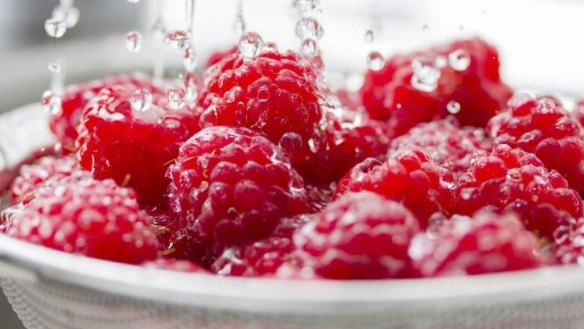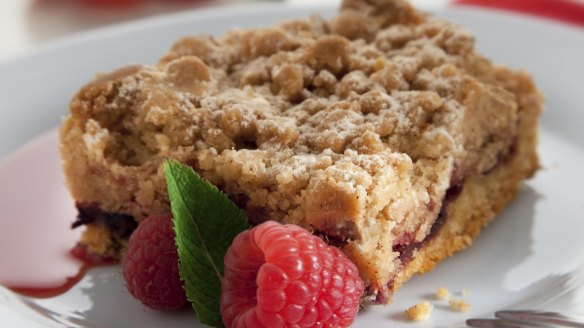Owen Pidgeon: How to grow great raspberries in Canberra for summer

One of the most delightful early summer treats is a dessert with a plateful of raspberries. This is a berry that you can grow in your home garden - sometimes with the help of your friends. And this is one berry that commands a premium at all retail outlets, so aim to grow your own.
You may have heard the old saying that a raspberry cane, once established, will spread and spread. My experience has been mixed, to say the least. Initially I had little success with canes purchased from nursery suppliers, I think because they had very poor root systems and a hot, dry summer is no good for establishing a new berry patch when the root systems are not mature - even if you remember to regularly water. Once the canes do being producing their thick mat of fibrous roots can become a long term powerhouse of production and they will keep fruiting for many years.
So we owe a special thanks to our niece Lesley Pidgeon who brought across several well established spring fruiting raspberry canes from her garden in Bathurst. Planted in a good location, we are now finally set up for the early summer harvest.
Then other good friends Bruce and Sheree Roe from McKellar dug out some of their surplus Heritage raspberry canes with wonderful sets of fibrous roots. These transplanted raspberries are growing strongly alongside our Autumn Bliss berries. So with everything progressing well now, we can now also enjoy a good supply of home grown raspberries for several months. Good gardening friends are indeed friends worth having.
Raspberries grow well in the cooler temperate regions, so Tasmania and the Canberra-Southern Highlands are very good locations. They will grow well in the same climate where you see cherries and apple orchards. When they are flowering and fruiting, keep them well watered, as the fruit needs plenty of water to fill out.
They are gross feeding plants so it is helpful to add in plenty of compost before planting and top up each spring time. Also keep them well mulched to cool the soil and retain the moisture from evening waterings. Our early summer fruiting canes are close to two metres with lots of little berries now appearing on the tips of the canes.
Most of the commercial varieties have been developed in north America, with the Chilcotin and Chilliwack early summer varieties being bred in the fertile valleys of British Columbia, just east of Vancouver.
Nootka is another high yielding variety for cooler climates. It came from the Vancouver Research Station. It will yield a good crop of medium-sized berries around Christmas time and then give you a supplementary Autumn flush. Williamette is the other dual cropping raspberry bred in Oregon, USA in the mid 1940s,
The Autumn fruiting varieties, such as the well known Heritage and Autumn Bliss raspberries are pushing up their new season canes right now. They will then produce their crop of berries on this season's wood.
In wintertime, you can simply cut back all the canes of the autumn varieties to near ground level. On the other hand, you will need to leave the new season canes standing for the early summer raspberries varieties, as they set fruit on their two-year-old canes.
This week in the garden
* Plant out rows of open leaf lettuce, bush beans, beetroot, bok choi and cucumbers.
* Harvest young tips of basil and sow another planter box of both basil and coriander for late summer supplies.
* Complete harvesting all garlic and check on the maturing of onions. If the onion bulbs are fully developed bend the stems over for a few days before harvesting.
* Regularly tie up the tomato stems to their stakes and pinch out laterals.
* Take the moment to complete mulching all garden beds before the Christmas break.
* Check apples for early signs of codling moth and remove any that have been infested, to prevent the second cycle.

Raspberry and apple flan
2 punnets fresh raspberries
6 cooking apples
2 tbs sugar
Pastry:
125g unsalted butter
2 tbs castor sugar
1½ cups plain flour
¼ cup self raising flour
1 free range egg
¼ cup custard powder
Crumble topping:
½ cup rolled oats
1¼ cups plain flour
½ cup brown sugar
2 tsps cinnamon
90g butter
Peel, quarter and slice the apples. Place them into a stainless steel saucepan with ½ cup water and cook until tender. Drain and allow to cool.
Pastry: Cut the butter into small segments and place in a medium sized bowl. Add the sugar and beat with an electric beater until light and fluffy. Add the egg and beat well. Add in the flours and the custard powder and mix in with a wooden spoon to form a smooth dough. Roll out the dough and line a 23 cm flan tin.
Topping: Combine the rolled oats, plain flour, sugar and cinnamon. Rub in the butter until it becomes a crumbly mixture.
Cover the flan dough base with the apple slices. Scatter the fresh raspberries across the apple and sprinkle the sugar over the fruit. Spread the topping over the fruit. Bake in oven set at 180C for approximately 45 minutes until pastry and crumble are golden brown.
Owen Pidgeon runs the Loriendale Organic Orchard near Hall.
Restaurant reviews, news and the hottest openings served to your inbox.
Sign up